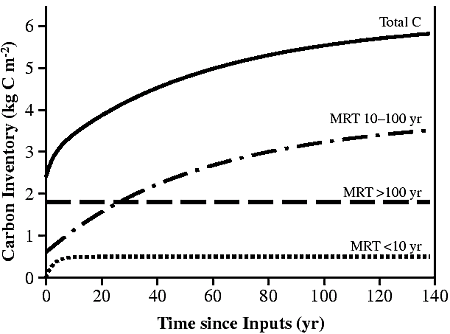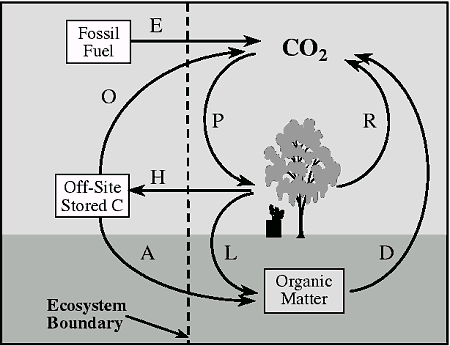|
4.2.1. Land Use, Management, and Ecosystem Carbon Balances (continued)
The main factors that determine the rate and duration of carbon gain in a given
ecosystem after a management change follow:
- The form the newly stored carbon takes. Carbon is stored in terrestrial
ecosystems in diverse organic forms with a wide range of mean residence times
(Balesdent and Mariotti, 1996; Harrison, 1996; Skjemstad et al., 1996;
Trumbore and Zheng, 1996). The mean residence time (MRT) is the average time
a carbon atom spends in a given pool. Some carbon-for example, much of the
carbon in fresh litter or non-woody biomass-is ephemeral and returns quickly
to the atmosphere (Stott et al. 1983). Other carbon, such as that in
woody materials or "active" soil organic matter fractions, may persist for
decades (Table 4-3). The most persistent stock of
carbon is stable soil carbon (including charcoal) that may have an MRT as
high as 1000 years or more because of chemical inertness or interaction with
soil minerals (Balesdent and Mariotti, 1996; Paul et al., 1997a). The
amount and duration of carbon gain within an ecosystem depend on the temporal
dynamics of these different pools: Transient pools may increase rapidly but
quickly level off, whereas carbon that is incorporated into more stable pools
can produce slow but long-term increases. Consequently, the initial impact
of land-use or management change occurs disproportionately in pools with shorter
residence times (Cambardella and Elliott, 1992; Huggins et al., 1998a), whereas
increases in stable soil pools occur slowly over a much longer time period
(see Figure 4-3).
- The degree of land-use or management change. The potential carbon
gain depends on the carbon stock potential of the new practice relative to
that of the previous practice (Greenland, 1995). Consequently, a wholesale
change from one land use to another (e.g., cropland to forestland) often elicits
the largest response in carbon stock change. Within a given land use, potential
carbon sequestration depends on how far the current carbon status is below
the eventual maximum storage of the newly adopted practice. All else being
equal, an ecosystem that has been under effective carbon-conserving management
for several years has less potential for further storage than one that has
been severely depleted of carbon. In ecosystems in which carbon stocks are
already near maximum, the primary focus may be preserving existing stocks.
- The persistence of current management and climatic regimes. Continued
accumulation of carbon in response to new management or land use depends on
continued application of that new practice; a reversal can lead to partial
or complete loss of previous gains (Dick et al., 1998; Stockfisch et
al., 1999). The long-term pattern of carbon accumulation also is responsive
to changes in climatic conditions. For example, accumulations of stored carbon
may be susceptible to loss from accelerated decomposition under higher temperatures
in future decades (Jenkinson, 1991; Trumbore et al., 1996), although
losses may be at least partially offset by the effects of CO2
fertilization (see Chapter 1). As carbon stocks increase,
so does the potential for future losses from regressive management or unfavorable
climatic conditions.
The effect of a new management or land use on atmospheric CO2
cannot be judged solely on the basis of net carbon storage within the ecosystem
(see Figure 4-4). In many "managed" ecosystems, there
is significant removal of carbon in harvested product. Some of this harvested
carbon may accumulate in long-term repositories (e.g., wood products), and some
is quickly returned to the atmosphere via respiration (e.g., agricultural products)
(see also Figure 2-2). Thus, the full impact
of a new management practice on atmospheric CO2
can be assessed only by including net changes in off-site carbon stocks.
|
Table 4-3: Possible repositories for additional
carbon storage in terrestrial ecosystems or their products, and approximate residence
times for each pool. Mean residence time is average time spent by a carbon atom
in a given reservoir.
|
|
| Repository |
Fraction
|
Examples
|
Mean Residence Time
|
|
| Biomass |
woody
|
tree boles
|
decades to centuries
|
| |
non-woody
|
crop biomass, tree leaves
|
months to years
|
|
| Soil organic matter |
litter
|
surface litter, crop residues
|
months to years
|
| |
active
|
partially decomposed litter;
carbon in macro-aggregates
|
years to decades
|
| |
stable
|
stabilized by clay; chemically
recalcitrant carbon; charcoal carbon
|
centuries to millennia
|
|
| Products |
wood
|
structural, furniture
|
decades to centuries
|
| |
paper, cloth
|
paper products, clothing
|
months to decades
|
| |
grains
|
food and feed grain
|
weeks to years
|
| |
waste
|
landfill contents
|
months to decades
|
|
Energy use-notably that from fossil fuel used to establish and maintain a given
land use-also affects the net exchange of carbon between the ecosystem and the
atmosphere (Figure 4-4). Consequently, if a management
or land-use change affects energy use, the corresponding CO2
emission affects the net carbon balance. For example, if an effort to increase
soil carbon in cropland requires higher fertilization, the CO2
from energy involved in manufacturing that fertilizer may partially offset soil
carbon gains (Flach et al., 1997; Janzen et al., 1998; Schlesinger,
1999). By replacing fossil fuel, biofuels can reduce the net emission of CO2
(Cole et al., 1997).

|
|
Figure 4-3: Predicted response of different
pools of soil organic matter for an agricultural soil converted to forest
in northeastern United States of America (Gaudinski et al., 2000).
Early response reflects changes in the relatively small pools with mean
residence time (MRT) <10 years (leaf and root residues). Pools with
intermediate MRT (10-100 years; including humified organics in litter
layers) dominate the overall response because this pool contains most
organic matter in this soil. Persistent carbon pools (MRT >100 years)
do not change appreciably over a 100-year period. MRT = average time
spent by a carbon atom in a given reservoir.
|
Some land management practices may also affect emission of GHGs other than
CO2, thereby augmenting or offsetting CO2
sources and sinks. For example, wetland restoration may increase methane emissions
(see Fact Sheet 4.18); greater use of nitrogen fertilizers
to enhance crop productivity (Fact Sheet 4.1) may enhance
N2O emissions; biomass burning emits CH4
and N2O; and conversion of arable land to grassland
may reduce N2O emissions (Fact
Sheet 4.7). Emissions from these activities are already estimated and reported
in a country's GHG inventory under the Revised Guidelines for National Greenhouse
Gas Inventories, hereafter referred to as the IPCC Guidelines (IPCC, 1997);
nevertheless, these emissions must be considered when a Party is contemplating
the adoption of any new carbon-conserving practices.

|
|
Figure 4-4: Simplified view of carbon cycle
in an ecosystem and associated off-site carbon. Designations are as
follows: P = photosynthesis; R = plant respiration [includes respiration
from herbivory and abiotic respiration (e.g., fire)]; H = harvest; L
= litter fall; D = decomposition; E = CO2-C
emission from energy use in the ecosystem; O = oxidation of harvested
carbon (e.g., consumption/respiration of food products, burning); A
= amendment of ecosystem with off-site organic carbon (e.g., biosolids,
wood chips). Net change in stored carbon = P - (R + D + H) - O. Net
effect of ecosystem on atmospheric CO2
= (E + O + D + R) - P. Some practices can reduce net emissions by substitution;
for example, biofuels reduce E by substitution with O.
|
|